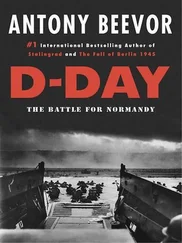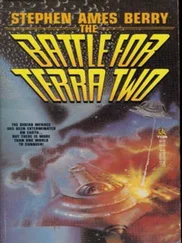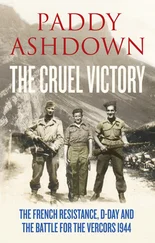He led his machine-gun section toward the field and into a network of enemy guns. Cole’s Marines fired into the gun slits as they passed. Cole knocked out two pillboxes himself with hand grenades. Then three bunkers pinned his men down in a cross fire. Cole silenced the nearest one with a counter cross fire. The enemy threw grenades. So did Cole. Three times he struck at the remaining pillboxes, finally knocking them out. But then a bursting grenade killed Sergeant Darrell Cole.
Not all of the Marine companies penetrated the enemy line so rapidly. One company was pinned down in a hail of fire for 45 minutes while its agonized men watched their captain, John Kalen, slowly bleed to death in a hole ringed around by exploding steel. Behind this unit, the guns of the cruiser Chester tried to blast a path inland for the Marines. The Chester ’s fire was directed by Lieutenant Commander Robert Kalen, who of course did not know that his brother was bleeding to death ashore. Before the day was over, command of this company changed hands four times.
As the enemy fire rose in fury so did the surf off all the beaches. Landing boats were caught up and hurled hard against the shore. They were wrecked, sunk or driven up on the beach, where they filled with water. Minute by minute the surf line was being turned into an impassable tangle of smashed boats, stalled and wrecked vehicles, bodies, crates, cartons and cans. From flank to flank the beachhead was marked by this long dark pile of debris, which surged with every wave. Offshore there was a swarm of landing boats. Every coxswain was convinced that he carried “hot” cargo; that is, badly needed supplies. All of them sought an opening in the tangle so that they could get ashore, unload and speed away from that place of exploding steel. In another hour or so, it might be impossible to get reinforcements or supplies ashore.
In the meantime, both Marine divisions had begun to call desperately for tanks. The big 15-ton Shermans could help turn the tide of battle. Their armor was thick enough to deflect most enemy missiles, and their 75-millimeter rifles were powerful enough to knock out most enemy positions. An hour after the invasion, 16 Shermans were landed in the 4 Division’s right-flank sector. But they had trouble getting through the beach terraces. On the 5’s left-flank beaches there was even more trouble. Lieutenant Henry Morgan’s tank, named Horrible Hank , was lost when a big wave swamped the lighter which carried it. Lieutenant Morgan radioed his commander: “Horrible Hank sank.” Then he went on to have two more tanks blown out from under him.
Everywhere the Shermans were being hit by shells. Few of them were knocked out, however; most of them continued to grind their way over the terraces. If they succeeded in getting over that obstacle, however, they entered deadly mine fields. Engineer troops had to precede the tanks on their knees, using their bayonets to poke for mines. They sought the mines by hand because mine detectors were not effective in the magnetic sand. Besides, most of the mines were made of a ceramic material instead of metal. So the gallant engineers gingerly cleared paths through the mines and marked them with white tape for the tanks.
Sometimes, if the tanks could not get through the terraces, the bulldozers cut paths for them. But the bulldozers were also shelled, and easily knocked out. Nevertheless, most of the Shermans got through. The Marine riflemen, however, greeted their arrival with mixed emotions. They knew what the tanks could do, but they also knew that the armored monsters would draw enemy fire. “It’s a tossup whether to run away from them,” said a corporal, “or crawl under them.”
Even before the tanks came in, the Navy beachmaster parties came ashore. It was their job to organize the beaches so that the flow of supplies to the fighting front would be smooth and steady. One of these beachmaster parties came right in after the first wave of Marines. The men landed with colored flags, bull horns, radios, portable generators and sandbags. The generators were dug in and sandbagged. The bull horns were set up on tripods to bellow orders that could be heard by supply-boat coxswains above the roar of guns and the surf. The flags were used to mark off the different beaches assigned to various Marine regiments, and the radios relayed the requests of the Marines to the ships offshore.
The assault troops battling grimly into Iwo’s defenses needed a wide variety of supplies. They required all kinds of ammunition, as well as fuel for their flame throwers, dynamite, barbed wire, water, grenades, gasoline and medical supplies. They also needed food rations. But there was never a question of which should come first—the “beans” or the “bullets.” The bullets always went in ahead. To get these supplies into the hands of the Marines, roads from the beaches had to be cut through the sand terraces which had already blocked the passage of so many vehicles. To do this, a battalion of Seabees came into Iwo Jima.
Seabees are sailor-specialists from Naval Construction Battalions. Their colorful nickname comes from the abbreviation C.B. Many of these highly trained technicians and mechanics were men in their thirties—or forties—who had put their civilian skills and crafts at their country’s service. Between the older Seabees and the youthful Marines there was a great bond of affection. They were the “old men” or the “kids” to each other.
Usually, Seabees had not come into an island until a day or two after the assault. But at Iwo Jima they arrived during the afternoon of D day! They were desperately needed to cut those roads through the terraces. Then supplies could be carried directly from the ships to the battlefield by amphibian trucks called DUKWS, or just plain “ducks.” When the ducks emerged dripping from the water, they displayed rubber wheels like any other truck and were able to roll anywhere. At Iwo, they were driven by Negro soldiers, who were the only Army troops to participate in the battle.
So the Seabees in their bulldozers cut swaths through the terraces, and some of them were killed or wounded as they worked. One bulldozer driven by Alphenix Benard came into the right-flank beaches in a tank lighter. When the ramp banged down, Benard saw a pile of American bodies blocking his path. He hesitated, horrified. But behind him were another bulldozer, two tanks and two tank-retrievers. He could not delay. He closed his eyes and drove over the bodies. “I had no choice,” Benard kept telling himself as his bulldozer butted through the terraced sand.
By noon the battle for Iwo had risen to a thunderous roar. Amtanks, or “armored pigs” as the Marines called them, still wallowed in the swells offshore to duel with Japanese batteries. Destroyers came in closer and closer and even the mighty battleship Tennessee hurled her great shells from a distance of only one mile. But all of this pounding was still not enough to knock down or blow up General Kuribayashi’s powerful positions. From Suribachi on the left flank and from the Quarry on the right flank, enemy artillery fire still rained down on the Marines. Even after they brought in their own artillery, the surest sign that the Americans had come to Iwo Jima to stay, the Marines’ counter-battery bombardments could not silence the well-concealed Japanese guns.
At one point, Kuribayashi began to use his highly prized rocket guns. They fired huge missiles varying from 200 to 550 pounds in weight. They were most inaccurate, although it was difficult for them to be harmless while exploding on Iwo’s crowded beaches. Still they were largely a failure. They had more bang than bite, passing overhead with a horrible blubbering noise. The Marines nicknamed them “bubbly-wubblies,” and soon came to regard them with contempt.
Читать дальше











